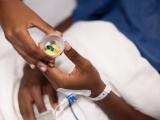A large one-day sampling of patients in intensive care units (ICUs) worldwide has found a high prevalence of suspected or proven infections, with a substantial risk of in-hospital mortality for infected patients.
The results of the multinational point-prevalence study, published yesterday in JAMA, found that, over a 24-hour period, 54% of ICU patients in 88 countries had a suspected or proven infection, with gram-negative bacterial infections accounting for more than two thirds of those infections. The in-hospital mortality rate was 30% among patients with infections, with the risk of death higher for patients with certain antibiotic-resistant pathogens.
The study also found that 70% of ICU patients were receiving at least one antibiotic, even though only 35% had positive microbiologic cultures.
A 1-day snapshot of ICUs
The study, dubbed EPIC (Extended Surveillance on Prevalence of Infection in Intensive Care) III, is the third in a series of ICU point-prevalence studies conducted over the past three decades. EPIC I, which included only European hospitals, and the larger EPIC II study, were conducted in 1992 and 2007. EPIC III is the largest and most inclusive of the three.
For the study, which was run by an international team of researchers using a similar design to the previous EPIC studies, physicians at 1,150 hospitals in 88 countries were asked to record all data on ICU patients during a 24-hour period starting on Sep 13, 2017. Data included hospital and patient characteristics, type of infection, isolated microorganisms, and antibiotics received. Follow-up data collected on Nov 13, 2017, included date of discharge or death.
Among the 15,165 patients with complete data in the study, 8,135 (54%) had at least one suspected or proven infection on the study day, and 1,921 (24%) had more than one. ICU infections accounted for 22% of infections, while healthcare-associated infections accounted for 35% and community-acquired infections 44%. Of the 5,259 patients with at least one positive microbiologic culture, 3,540 (67%) had a gram-negative organism, 1,946 (37%) had a gram-positive organism, and 864 (16%) had a fungal organism.
The proportion of patients with an infection ranged from 43% in Australasia to 60% in Asia and the Middle East. The researchers say the observed variation in infection rate was associated with patient-specific and disease-specific factors, as well as differences in healthcare resources and the ability of hospitals to provide care.
A total of 10,640 ICU patients (70%) were receiving an antibiotic, with 4,217 (28%) receiving prophylactic antibiotics and 7,723 (51%) receiving therapeutic antibiotics. The appropriateness of these antibiotics was not assessed.
Analysis of clinical outcomes of 7,936 infected patients with suspected or proven infection and available outcome data found that 2,404 (30%) died at the hospital. A multilevel analysis of patients with positive cultures for infection found that ICU-acquired infection was independently associated with higher risk of death compared with community-acquired infection (odds ratio [OR], 1.32; 95% confidence interval [CI], 1.10 to 1.60; P = .003).
Further analysis of patients with positive cultures who died found that infection with vancomycin-resistant Enterococcus (OR, 2.41; 95% CI, 1.43 to 4.06; P = .001); Klebsiella resistant to beta-lactam antibiotics, including third-generation cephalosporins and carbapenems (OR, 1.29; 95% CI, 1.02-1.63; P = .03); and carbapenem-resistant Acinetobacter species (OR, 1.40; 95% CI, 1.08-1.81; P = .01) were all independently associated with a higher risk of death when compared with infection with another microorganism.
High mortality, antibiotic use need addressing
The overall rate of infection found in the EPIC III study was higher than the two previous EPIC studies. In EPIC I, 45% of ICU patients had an infection, while EPIC II found that 51% of ICU patients had an infection. The authors say the higher infection rate could potentially be the result of protocol changes and improved technology. The mortality rate observed in EPIC II was 33%.
In an accompanying commentary on the EPIC III results, infectious disease experts from Singapore, Thailand, and the United States say the most striking finding is how little the results, in terms of the prevalence of infection and the associated mortality rates, differ from the previous two studies.
"It is disappointing that mortality remains so high despite the focus on the early recognition and management of sepsis over the years," they write. "This could raise concerns about possible stagnation in investments by governments and pharmaceutical companies in antibacterial therapeutics and diagnostics, especially with multidrug-resistant bacteria becoming more common."
They also note that the high rate of antibiotic use observed in EPIC III is a cause for concern and highlights how challenging it is to implement effective stewardship interventions in settings where patients are critically ill, diagnostics are slow and imprecise, and clinicians are reluctant to de-escalate or discontinue antibiotics.
"There is a need for novel approaches to optimize antibiotic use in these critically ill patients to enable better outcomes while minimizing the collateral harms associated with antimicrobial resistance," they write.
The authors of the commentary say the findings highlight the need for development of novel diagnostics and therapeutics to reduce the high levels of infection-related ICU mortality.























